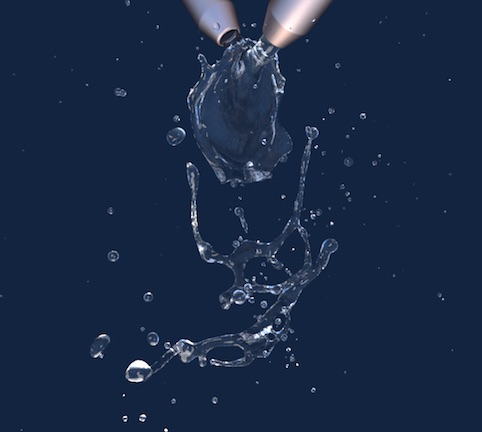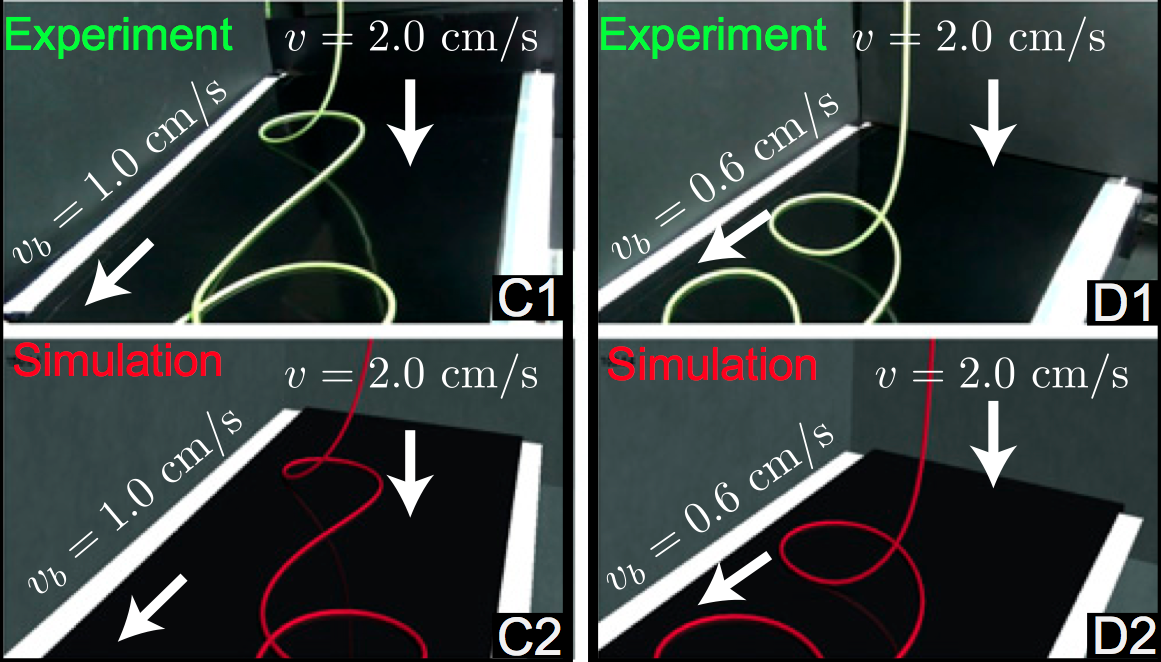
Fang Da
- 6LE4, CEPSR Building
- Computer Science Department
- Columbia University
- 530 West 120th St
- New York, NY 10027
- Email:

- Résumé: PDF
I completed my PhD degree in 2016 in computer science at Columbia University, advised by Professor Eitan Grinspun. My research involves physically based animation techniques, with a particular focus on the modeling and simulation of fluid phenomena.
I received my B.S. degree at Peking University in 2007, and M.S. degree at Columbia University in 2012.
My latest résumé is here.
Publications
|
|
Surface-Only Simulation of Fluids
Dissertation.
Abstract:
Surface-only simulation methods for fluid are those that perform computation only on a surface representation, without relying on any volumetric discretization. Such methods have superior asymptotic complexity in time and memory than the traditional volumetric discretization approaches, and thus are more tractable for simulation of complex fluid phenomena. Although for most computer graphics applications and many engineering applications, the interior flow inside the fluid phases is typically not of interest, the vast majority of existing numerical techniques still rely on discretization of the volumetric domain. My research first tackles the mesh-based surface tracking problem in the multimaterial setting, and then proposes surface-only simulation solutions for two scenarios: the soap-films and bubbles, and the general 3D liquids. Throughout these simulation approaches, all computation takes place on the surface, and volumetric discretization is entirely eliminated.
[PDF] [High-resolution PDF]
|
|
|
Surface-Only Liquids
Fang Da, David Hahn, Christopher Batty, Chris Wojtan, Eitan Grinspun
ACM Transaction on Graphics (Proceedings of SIGGRAPH 2016).
Abstract:
We propose a novel surface-only technique for simulating incompressible, inviscid and uniform-density liquids with surface tension in three dimensions. The liquid surface is captured by a triangle mesh on which a Lagrangian velocity field is stored. Because advection of the velocity field may violate the incompressibility condition, we devise an orthogonal projection technique to remove the divergence while requiring the evaluation of only two boundary integrals. The forces of surface tension, gravity, and solid contact are all treated by a boundary element solve, allowing us to perform detailed simulations of a wide range of liquid phenomena, including waterbells, droplet and jet collisions, fluid chains, and crown splashes.
[PDF] [Project] [MOV]
|
|
|
Double Bubbles Sans Toil and Trouble: Discrete Circulation-Preserving Vortex Sheets for Soap Films and Foams
Fang Da, Christopher Batty, Chris Wojtan, Eitan Grinspun
ACM Transaction on Graphics (Proceedings of SIGGRAPH 2015).
Abstract:
Simulating the delightful dynamics of soap films, bubbles, and foams has traditionally required the use of a fully three-dimensional many-phase Navier-Stokes solver, even though their visual appearance is completely dominated by the thin liquid surface. We depart from earlier work on soap bubbles and foams by noting that their dynamics are naturally described by a Lagrangian vortex sheet model in which circulation is the primary variable. This leads us to derive a novel circulation-preserving surface-only discretization of foam dynamics driven by surface tension on a non-manifold triangle mesh. We represent the surface using a mesh-based multimaterial surface tracker which supports complex bubble topology changes, and evolve the surface according to the ambient air flow induced by a scalar circulation field stored on the mesh. Surface tension forces give rise to a simple update rule for circulation, even at non-manifold Plateau borders, based on a discrete measure of signed scalar mean curvature. We further incorporate vertex constraints to enable the interaction of soap films with wires. The result is a method that is at once simple, robust, and efficient, yet able to capture an array of soap films behaviors including foam rearrangement, catenoid collapse, blowing bubbles, and double bubbles being pulled apart.
[PDF] [Project] [MP4]
|
|
|
Propulsion and Instability of a Flexible Helical Rod Rotating in a Viscous Fluid
Khalid Jawed, Noor Khouri, Fang Da, Eitan Grinspun, Pedro Reis
Physical Review Letters (PRL). 2015.
[Paper]
|
|
|
Multimaterial Mesh-Based Surface Tracking
Fang Da, Christopher Batty, Eitan Grinspun
ACM Transaction on Graphics (Proceedings of SIGGRAPH 2014).
Abstract:
We present a triangle mesh-based technique for tracking the evolution of three-dimensional multimaterial interfaces undergoing complex deformations. It is the first non-manifold triangle mesh tracking method to simultaneously maintain intersection-free meshes and support the proposed broad set of multimaterial remeshing and topological operations. We represent the interface as a non-manifold triangle mesh with material labels assigned to each half-face to distinguish volumetric regions. Starting from proposed application-dependent vertex velocities, we deform the mesh, seeking a non-intersecting, watertight solution. This goal necessitates development of various collision-safe, label-aware non-manifold mesh operations: multimaterial mesh improvement; T1 and T2 processes, topological transitions arising in foam dynamics and multi-phase flows; and multimaterial merging, in which a new interface is created between colliding materials. We demonstrate the robustness and effectiveness of our approach on a range of scenarios including geometric flows and multiphase fluid animation.
[PDF] [Bib] [Project] [MP4] [C++ Code]
|
|
|
Coiling of Elastic Rods on Rigid Substrates
Khalid Jawed, Fang Da (Joint first author), Jungseock Joo, Eitan Grinspun, Pedro Reis
Proceedings of the National Academy of Sciences (PNAS). 2014.
Abstract:
We investigate the deployment of a thin elastic rod onto a rigid substrate and study the resulting coiling patterns. In our approach, we combine precision model experiments, scaling analyses, and computer simulations toward developing predictive understanding of the coiling process. Both cases of deposition onto static and moving substrates are considered. We construct phase diagrams for the possible coiling patterns and characterize them as a function of the geometric and material properties of the rod, as well as the height and relative speeds of deployment. The modes selected and their characteristic length scales are found to arise from a complex interplay between gravitational, bending, and twisting energies of the rod, coupled to the geometric nonlinearities intrinsic to the large deformations. We give particular emphasis to the first sinusoidal mode of instability, which we find to be consistent with a Hopf bifurcation, and analyze the meandering wavelength and amplitude. Throughout, we systematically vary natural curvature of the rod as a control parameter, which has a qualitative and quantitative effect on the pattern formation, above a critical value that we determine. The universality conferred by the prominent role of geometry in the deformation modes of the rod suggests using the gained understanding as design guidelines, in the original applications that motivated the study.
[PDF] [Bib] [Project] [C++ Code]
|






